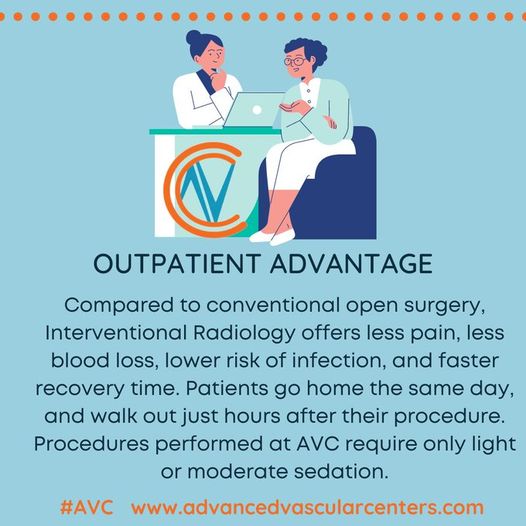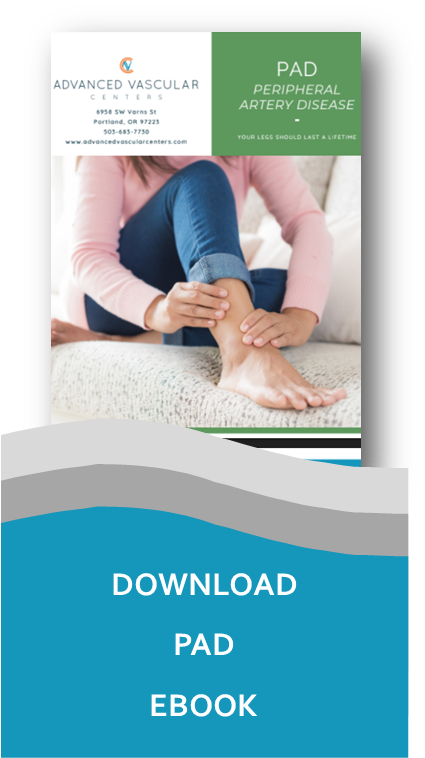PERIPHERAL ARTERIAL DISEASE (PAD)
Peripheral arterial disease, or PAD, is a serious health problem in the United States and it is significantly under diagnosed. Peripheral arterial disease specialists warn that one-third of all patients who require amputation as a result of PAD will die within 2 to 4 years and nearly 50% won’t live more than 5 years. There is also evidence that those who suffer from peripheral arterial disease most likely have other areas with blocked arteries, which can lead to heart attacks and stroke. Risk factors include aging, diabetes, and smoking.
DOWNLOAD PERIPHERAL ARTERIAL DISEASE BROCHURE
Contact AVC to see if Angioplasty and Vascular Stenting may be right to treat your PAD.
Peripheral Artery Disease Overview
Peripheral Artery Disease (PAD) is a disorder that occurs in the arteries of the circulatory system, the series of vessels that moves blood throughout the body. In PAD, the walls of the arteries become narrowed or blocked with plaque. Plaque is a combination of cholesterol, fat and/or scar tissue.
PAD affects the limbs, usually the legs. Left untreated, it can cause many serious and life-threatening conditions including amputation, stroke or heart attack. PAD also is known as hardening of the arteries, atherosclerosis and peripheral vascular disease. It’s estimated that one in every two persons, age 60 or older, has peripheral arterial disease.
The Outpatient Difference
When you get treatment at one of AVC’s outpatient labs, you will receive the highest level of exceptional care.
- cutting edge non-surgical procedure
- solves urination problems
- reduced pain & fast recovery
- safe with low rate of side effects
- erectile & sexual functions are maintained
- effective lasting results
- same-day outpatient care
- comfortable sedation/anesthesia
At AVC, our award-winning physicians are expertly trained to use non-surgical, minimally invasive procedures, using advanced imaging and device technology, to achieve effective results. During the same day outpatient procedure, one of our Interventional Radiologists (IRs) can treat PAD and provide patients with immediate relief.
Peripheral Artery Disease Symptoms
- Pain or heaviness in the legs
- Cramping in the legs while walking that is relieved by rest (claudication)
- Reduced or absent pulse in the ankle or foot
- Leg numbness
- Sores on toes, feet or legs that won’t heal
- Coldness in lower leg or foot, especially compared to the other leg
How is PAD diagnosed?
Advanced Vascular Centers works with the best ultrasound techs to use new and advanced techniques to diagnose PAD. It is often diagnosed by checking pulse rates and comparing blood pressure between the ankle and arm.
If you experience any of the following, contact us to discuss treatment options.
What Are The Treatment Options For PAD?
Angioplasty and Vascular Stenting
Atherosclerosis causes narrowing or blockage of the arteries supplying the legs, or more rarely, the arms. Blockages of these arteries can cause claudication (pain with walking), rest pain (pain occurring at rest), or tissue loss (gangrene or an open wound, usually on the foot or ankle). Opening these blockages and restoring blood flow can reverse these problems.
Radiofrequency and Laser Ablation
Laser ablation closes the vein with laser energy, a long, thin tube (catheter) is inserted through the skin and into the faulty vein. The only discomfort you feel during the procedure is from the very tiny needles used to inject lidocaine, a local anesthetic, in the skin and around the veins we are treating.
As doctors, we owe it to YOU, to give you two things:
- All of your treatment options, both surgical and non-surgical.
- Our professional opinion about each of these options for YOU.
PAD TREATMENT OPTIONS
ANGIOPLASTY AND VASCULAR STENTING
Preparation:
- Eating: Do not eat any solid food for 6 hours prior to your procedure, you may have clear liquids up to 2 hours prior to the procedure, examples of clear liquids include; water, fruit juices without pulp, carbonated beverages, clear tea, and black coffee. Orange juice is not a clear liquid
- Medications: Most people should continue to take their prescribed medications. If you are diabetic and are taking Glucophage, Glucovance, or Avandamet you must not take the medication for two days after the examination. Also, you must have a blood test to check your kidney function before restarting the above medications. Ask your physician for instructions. If you are a diabetic and taking insulin, you should ask your physician for specific instructions regarding the dosages for the day of your examination. If you are taking Coumadin or other medications to thin your blood, you must tell your doctor so that it can be stopped. Bring all your medications with you.
- Allergies: If you are allergic to contrast (X-ray dye) or iodine, let your doctor know as soon as possible so they may plan to take special precautions before and during the procedure.
- Smoking: Do not smoke for at least 24 hours before your angioplasty.
During:
The artery is accessed with a small puncture, and the area of blockage is crossed using specialized wires and catheters. The blockage is then opened using balloon inflation (angioplasty), flexible metallic tubes (stents), or by directly removing the atherosclerotic plaque (atherectomy).
It is common for patients to feel some mild discomfort when the balloon is inflated. This is because the artery is being stretched. Discomfort is more noticeable when veins are opened or dilated. This discomfort should decrease as the balloon is deflated.
After:
The site where the catheter was inserted may be bruised and sore. This is temporary. For several hours, your blood pressure and heart rate will continue to be monitored and your catheter site will be checked for bleeding or swelling. If the procedure is performed for vein disease, bleeding is less likely compared to arterial disease and you may be discharged earlier.
RADIOFREQUENCY AND LASER ABLATION
Preparation:
- Eating: Do not eat any solid food for 6 hours prior to your procedure, you may have clear liquids up to 2 hours prior to the procedure, examples of clear liquids include; water, fruit juices without pulp, carbonated beverages, clear tea, and black coffee. Orange juice is not a clear liquid
- Medications: Most people should continue to take their prescribed medications. If you are diabetic and are taking Glucophage, Glucovance, or Avandamet you must not take the medication for two days after the examination. Also, you must have a blood test to check your kidney function before restarting the above medications. Ask your physician for instructions. If you are a diabetic and taking insulin, you should ask your physician for specific instructions regarding the dosages for the day of your examination. If you are taking Coumadin or other medications to thin your blood, you must tell your doctor so that it can be stopped. Bring all your medications with you.
- Allergies: If you are allergic to contrast (X-ray dye) or iodine, let your doctor know as soon as possible so they may plan to take special precautions before and during the procedure.
- Smoking: Do not smoke for at least 24 hours before your angioplasty.
During:
The artery is accessed with a small puncture, and the area of blockage is crossed using specialized wires and catheters. The blockage is then opened using balloon inflation (angioplasty), flexible metallic tubes (stents), or by directly removing the atherosclerotic plaque (atherectomy).
It is common for patients to feel some mild discomfort when the balloon is inflated. This is because the artery is being stretched. Discomfort is more noticeable when veins are opened or dilated. This discomfort should decrease as the balloon is deflated.
After:
The site where the catheter was inserted may be bruised and sore. This is temporary.
For several hours, your blood pressure and heart rate will continue to be monitored and your catheter site will be checked for bleeding or swelling. If the procedure is performed for vein disease, bleeding is less likely compared to arterial disease and you may be discharged earlier.

APPOINTMENT REQUEST




FAQS
What is the main cause of PAD?
The cause of PAD is atherosclerosis. This happens when plaque builds up on the walls of the arteries that supply blood to the arms and legs. Plaque is a substance made up of fat and cholesterol. It causes the arteries to narrow or become blocked.
What vitamin is good for blood circulation?
Vitamin B3 can help people improve blood circulation. Also called niacin, B3 reduces inflammation and bad cholesterol. The vitamin is also important for increasing blood vessel function. Leafy green vegetables such as kale and spinach are good sources of vitamin B nutrients.
What foods are good for peripheral artery disease?
Foods rich in fiber include chickpeas, beans, brown rice, nuts, popcorn, and dried fruits. Some of the best overall foods to eat for PAD include fruits, vegetables, lean meats, and whole grains. Monounsaturated, polyunsaturated, and Omega3 fats are all healthy ingredients for a PAD diet.
Can you live a long life with PAD?
If you have PAD your chances of living a long life decrease dramatically—in fact, if you have severe PAD you have less chance of being alive after five years than if you have some common cancers like colon cancer or lymphoma.
Is walking good for peripheral artery disease?
Walking is especially good for you. Several randomized clinical trials have shown that walking can make a real difference for people with peripheral artery disease.

